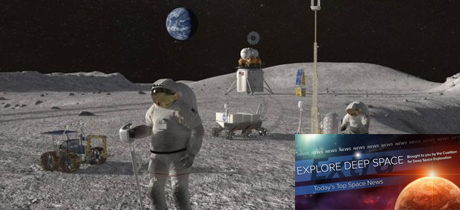In Today’s Deep Space Extra… Congress seeks more information from NASA on the cost and milestones for reaching the Moon’s surface with human explorers in 2024, four years earlier than previous estimates. Boeing’s uncrewed CST-100 Starliner test launch to the International Space Station (ISS) moves from April to August. Mars may have water deep underground.
Human Space Exploration
Moon 2024 gets cool reception by House Committee democrats
Spacepolicyonline.com (4/2): In testimony Tuesday before the U.S. House Committee on Science, Space and Technology, NASA Administrator Jim Bridenstine said the agency will soon provide lawmakers with a new budget request, hopefully by April 15, devised to make possible the return of human explorers to the lunar surface by 2024, four years earlier than previous projections. The committee members sought details on cost and plans to achieve the goal that the administrator did not provide with his opening statement. The White House proposed a $500 million reduction in NASA’s 2020 budget request over the $21.5 billion appropriated for 2019.
NASA will ask Congress for more money to get to Moon in 5 years
Axios.com (4/2): NASA administrator Jim Bridenstine plans to request more money from Congress in order to meet the Trump administration’s new deadline of landing astronauts on the Moon by 2024, he told the House Science, Space and Technology Committee on Tuesday.
Why it matters: NASA will need more funding if it plans to achieve President Trump’s new goal of sending astronauts to the moon in the next five years — four years earlier than planned. NASA also intends to use this Moon mission as a stepping stone to send people to Mars.
Boeing will delay test launch of its astronaut capsule to August, citing ‘schedule pressure’
Coalition Members in the News – Boeing, United Launch Alliance
Orlando Sentinel (4/2): NASA’s Commercial Crew Program partner, the Boeing Co., announced Tuesday it will delay the uncrewed test launch of its CST-100 Starliner to the International Space Station (ISS) from April until August. Boeing listed a second near term launch of a United Launch Alliance (ULA) Atlas 5 with a national security payload as the source of schedule pressure it can avoid with the re-scheduling. A second test flight of the Starliner with astronauts remains possible by year’s end, according to Boeing. NASA’s second Commercial Crew partner, SpaceX, carried out a successful uncrewed test flight to the Station of its Crew Dragon in March.
NASA says debris from India’s antisatellite test puts Space Station at risk
New York Times (4/2): India’s leadership is hailing the success of a controversial antisatellite test last week, “India stands tall as a space power,” declared India’s Prime Minister Narendra Modi in the aftermath. In the U.S., NASA Administrator Jim Bridenstine declared the orbital debris created by last week’s test a risk to astronauts aboard the International Space Station (ISS) and a range of multinational satellite assets.
Space Science
Mars may have lots of water deep underground
Space.com (4/2): Mysterious dark streaks called recurring slope linae that appear seasonally on sloped regions of the Martian terrain have been theorized on originate with briny water in the planet’s subsurface. A new study, however, suggest that the source may be water whose origin is deep below the surface and forced up under pressure and through cracks. Researchers from the University of Southern California (USC) and NASA’s Jet Propulsion Laboratory (JPL) led the study, whose findings are published in Nature Geoscience.
More than a carbon copy: OCO-3 on the Space Station
NASA Jet Propulsion Laboratory (4/2): Soon, the International Space Station (ISS) is to become the vantage point for NASA’s third Orbital Carbon Observatory. Carbon cycles naturally from animals to plants in the Earth’s atmosphere. Keeping a balance is key to keeping the atmosphere from warming in ways that could be harmful to all.
Other News
NASA announces top three designs for homes on Mars
CNN (4/1): NASA’s 3-D Printed Habitat Challenge has produced three recent winners, engineering teams with a vision of how advanced technologies might be used to create human habitats from natural resources found on distant planetary bodies. The competition has been underway since 2015.

